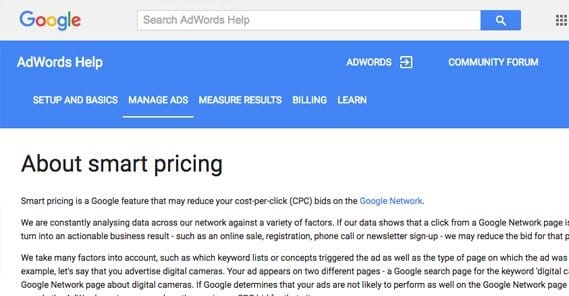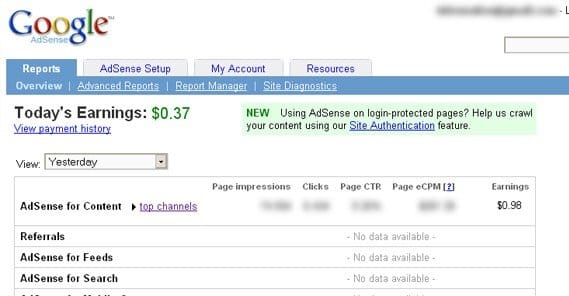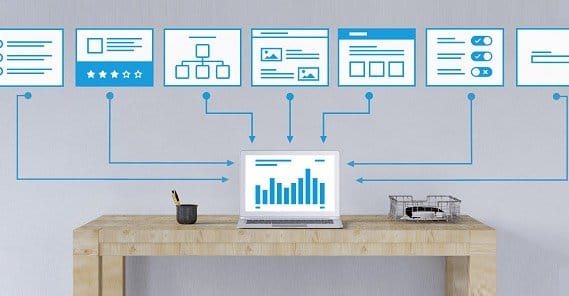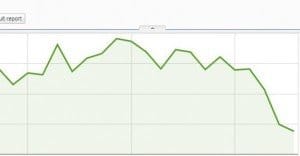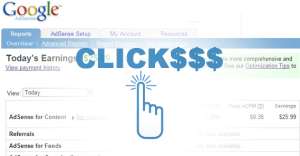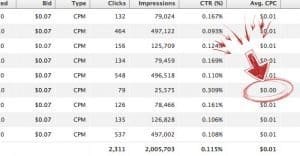Why Your Google Ads Have High Clicks But Low Earnings
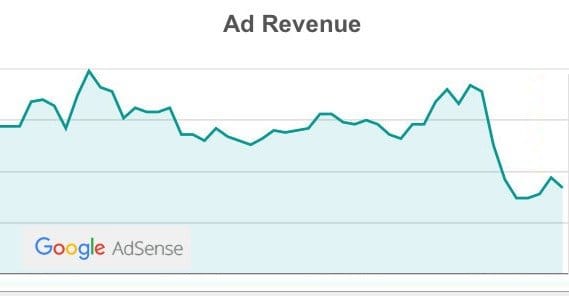
PPC is interesting to me because everyone always seems focused on one aspect of it primarily; the cost per click. There’s an endless search for cheaper clicks, and it seems like that’s because people perceive it as the only tangible aspect of PPC they can control. Your costs go down if you get cheaper clicks, so they seek out cheaper clicks. Any other optimization – better click rates, better conversion rates, higher value conversions, and the like – all are derived metrics. They’re not a tangible “if I do X, my costs decrease” metric.
This leads to many situations where you may have a quite low cost per click, and even a high number of clicks, but low earnings. You’re not spending much, and you’re getting a lot of traffic for it, but what is it doing for you? If those people aren’t buying anything, they aren’t doing you any good. You may as well just buy bot traffic.
One of the major culprits, as it turns out, is Google’s Smart Pricing.
All About Smart Pricing
Google’s Smart Pricing is an automatic system that has been in place since 2004, so it’s nothing new. However, it’s also not really a major component of what many people consider when they think about their PPC ads. To them, it’s all just part of the mysterious algorithm that produces the numbers they see in their analytics reports.
The concept behind Smart Pricing is pretty simple. The idea is that if your ads are running in multiple locations, Google is paying attention to how they perform in each location. If your ads are displayed on three different sites, and they’re doing much worse on one site than the other two, Google will adjust the pricing for that one site. They drive the cost down, since it’s preferable to them that you’re paying less for less effect. The alternative is that you’re paying more for unsatisfactory performance, and you stop that campaign, leading to no payments at all.
Google isn’t doing this out of greed, of course. They’re trying to create a scenario where you pay less for ads that aren’t performing well, as a sort of sanity check against spending a lot of money on ineffective ads. It’s the opposite of Facebook’s push to everyone to use the Boost Post feature, which is largely ineffective and often leads to budgets wasted on nothing of value.
This Smart Pricing adjustment is an ongoing calculation. As your ads run, they are monitored. If performance drops, so too will costs. If performance rises, again, so too will costs. It’s a dynamic adjustment that you can’t control or opt out of.
Unfortunately, that means it can hurt your ads overall. If you have some that don’t perform well, it can tank your costs, which tanks your visibility and performance even further. It’s a cycle that can be hard to pull out of.
The ideal result of smart pricing is something like this. It tanks costs for you, which allows you to pay for more clicks. However, it also tanks the amount Google pays the publisher, which is an incentive for that publisher to improve the relevance of their content, and you the relevance of your ads. If the publisher makes chances that makes your ads more effective, their payments will rise. If you make chances to make your ads more effective, your costs will rise, but so too will your conversions. Ideally, even if your costs go up, your profits go up faster so you end up making more overall.
The reality is that, most of the time, the site either won’t change or will adjust themselves in the wrong direction. They appeal to the ads that are working well on their site, which means moving away from you and your ads. Your situation gets worse, theirs either stays the way it was or improves, and you’re left waiting to get placement on a different site in the display network.
The Publisher Perspective
As a publisher, smart pricing tanks the earnings you get from the ads you’re running. The idea is that the lower earnings are an incentive to try to figure out what’s wrong, what the disconnect is, and how to fix it. Once you make some changes and get more relevant content for your ads or vice versa, your ad value can rise again.
Smart pricing kicks in when visitors click your ads but don’t like what they see. Ads are designed to convert in some way. The idea is that the people you’re sending along your ads are going to perform that conversions, whether it’s filling out an email form or buying a product. If your clicks aren’t converting, those clicks aren’t worth anything to the advertisers, so Google kicks in their smart pricing. It’s a punishment to get you to send better traffic, however you manage to do that.
Through over a decade of research and evidence, most information about performing well in AdSense and AdWords comes from knowledge about Smart Pricing, even if that knowledge isn’t direct. People might not understand how Smart Pricing works directly – Google loves their secrets, after all – but they understand what the ads program likes and what it doesn’t like.
Avoiding Smart Pricing
Smart Pricing does seem to love themed websites. Niches websites covering one topic in great detail are excellent, because the traffic coming in is entirely focused on that one topic. That means the clicks you send out are clicks interested in that one topic, which means Google can serve ads dedicated to that one topic and be assured of a higher degree of interest.
Think of it like this. A website devoted to plumbing of all kinds can cover a wide range of topics. Ads devoted to faucets might work, ads devoted to types of PVC connector might work, ads devoted to copper pipes can work, but they’re all niches inside the plumbing niche. If that site hasn’t really covered PVC pipes that much, ads about PVC aren’t going to be as relevant and might end up underperforming.
On the other hand, a small niche site dedicated to all things PVC, usage and restrictions and problems and all the rest, only has that one small type of ad to display. However, anyone visiting that site is going to be interested in that topic, so anyone clicking those ads already has that interest in PVC.
Of course, the broad topic of Plumbing as a whole is still narrow enough to trigger Smart Pricing. For that, you need to go even broader.
Home Improvement in general might be too broad a topic for a smaller site. You can cover a lot of different topics, but you’re not getting a lot of focused traffic. Some of your audiences came in looking for plumbing, some looking for electrician information, some about carpentry, some about paint. Ads about any given one of those will only be interesting to a small fraction of the people visiting the site, and thus the site can end up Smart Priced.
“But wait! What about <insert big name site here>? They’re a huge generalist site, and they get away with it.”
Well, do they? There are a few things wrong with that assumption. A site like HGTV’s might cover a broad range of home and gardening – and television – topics, but they also have tens of thousands of pages of content. Their individual section on painting may be as large as a niche site on painting itself. There are enough pages and enough content on each topic to show ads to those users and get targeted clicks.
At the same time, how do we know they aren’t Smart Priced? I certainly don’t have access to their Google data. Anyone who does is probably bound by a nondisclosure agreement regarding that data.
On top of that, a lot of the larger sites don’t run basic Google display ads. If they do, they might be running ads from other systems as well. Some of them don’t run ads at all, and make their money through other forms of monetization, like selling data, products, or consultation.
Coping With and Recovering From Smart Pricing
Smart Pricing can be devastating to a small business or small blog that is relying entirely on thin margins and Google ad revenue to survive. It can demolish your income overnight, and it’s only calculated about once a week, so you’re stuck even if you make the appropriate changes right away.
So what triggers smart pricing? I’ve already covered the broad topic curse, but that’s only an issue because an overly broad topic means a lower percentage of interested ad clickers. The biggest possible problem is the incoming traffic quality itself. Low quality traffic, unfocused traffic, isn’t going to be interested in the topic and isn’t likely to be interested in clicking your ads.
There seems to be a solution here, but there isn’t. Ideally, disinterested users wouldn’t click ads. The problem is, people have built up such a natural aversion to ads over the years that ad providers have taken a lot of effort to make their ads seem like normal links on the web. This means that your poor traffic will click whatever links they feel like, which will often be the prominently positioned native ads. Those clicks lead to landing pages they don’t care much about, so they don’t convert, so the ads get a bad rap. That gets you Smart Priced.
So, to avoid this whole situation and to avoid Smart Pricing, you should see how many of these you can do.
- Avoid bot traffic. High quality traffic and targeted ads are fine, but bot traffic is not.
- Make sure your content is sufficiently high quality and compelling enough to attract real readers. Ideally you want most of your traffic coming from organic sources, and you want those sources to be related to your topic in some way. That means relevant links or keyword-specific Google search results.
- Consider using an ad injection method to limit your ads to only display to people coming in from certain valuable traffic sources. This has the secondary effect of making sure that you’re protected from anyone trying to tank your profits by click-bombing your ads.
- Make sure you don’t have bad individual sites on your account. Smart Pricing goes by AdSense account, not just by property, so one bad apple can spoil the bunch.
- Consider removing some ad units from the offending site and focusing on fewer, higher quality clicks rather than more clicks. Sure, your volume will go down, but you can’t fight Smart Pricing with volume; it will just drop further.
Additionally, pay attention to the ads that are being placed on your site. It’s all well and good to have a content plan and a topic you stick to, but if there aren’t many ads for that topic, you’ll end up with ads that aren’t quite joined with your content. That decreases the conversion rate for those ads, and can get you Smart Priced.
I recommend paying attention to who is advertising on your site and write some content more specifically targeting them. You already have the ads; why not recommend their content? You can’t point to specific ads in your content, because they might not always be the same ads, and because it’s against the Google terms. Instead, you just need to write content passively recommending what you know to be advertised on your site.
One thing you should recognize, though, is that not all drops in revenue are actually smart pricing. There are plenty of other reasons why you might not be getting as much out of your ads as you used to. Likewise, there are a lot of ways you can grow your revenue without specifically attempting to counteract Smart Pricing. Try to implement what makes sense for your site, and don’t worry about a boogeyman.
 ContentPowered.com
ContentPowered.com
